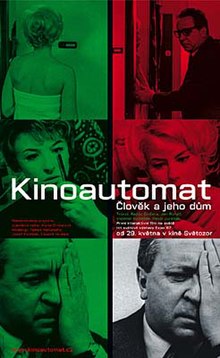Kinoautomat
| Kinoautomat: One Man and His House |
|
|---|---|
 |
|
| Directed by |
Radúz Činčera Ján Roháč Vladimír Svitáček |
| Produced by | Ladislav Kalas |
| Written by |
Pavel Juráček Radúz Činčera Miroslav Horníček Ján Roháč Vladimír Svitáček |
| Starring | Miroslav Horníček |
| Music by | Evžen Illín |
| Cinematography | Jaromír Šofr |
| Edited by | Miroslav Hájek |
|
Release date
|
|
|
Running time
|
63 minutes |
| Country | Czechoslovakia |
| Language |
Czech English (dubbed) |
Kinoautomat (1967) was the world's first interactive movie, conceived by Radúz Činčera for the Czechoslovak Pavilion at Expo 67 in Montreal. At nine points during the film the action stops, and a moderator appears on stage to ask the audience to choose between two scenes; following an audience vote, the chosen scene is played.
The film is a black comedy, opening with a flash-forward to a scene in which Petr Novák (Miroslav Horníček)'s apartment is in flames. No matter what choices are made, the end result is the burning building, making the film—as Činčera intended—a satire of democracy. Other interpretations are that the film is a satire of determinism, the idea that human beings control their fate, or that the film is an endorsement of acceptance of the diversity and complexity of life. The latter would be in keeping with other statements of late 60s culture which questioned social structure and authority.
The version presented in Montreal had been dubbed into English in London, and was subtitled One Man and his House. The production took place in a custom-built cinema, with buttons installed on each of the 127 seats, one green and one red. The lead actor (Horníček) performed the moderator's role phonetically, since he spoke no English. As the audience cast their vote, the result of each choice was displayed on the perimeter of the screen, with a numbered panel corresponding to each seat turning red or green according to the button pressed. The interactive element was achieved by switching a lens cap between two synchronised projectors, each with a different cut of the film.
The project was well received, with The New Yorker writing: "The Kinoautomat in the Czechoslovak Pavilion is a guaranteed hit of the World Exposition, and the Czechs should build a monument to the man who conceived the idea, Radúz Činčera." Initially, Hollywood studios were keen to license the technology, but under the Communist government the Kinoautomat concept was the property of the state, and never made the transition.
...
Wikipedia
